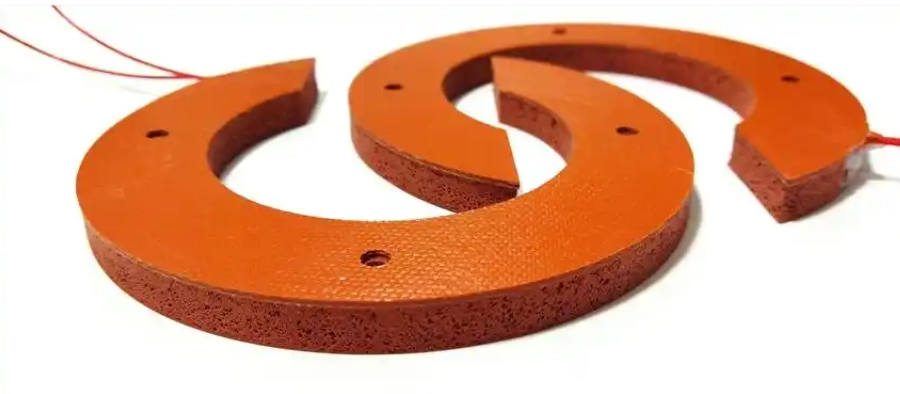Many industries today rely on stable, controllable heat. Equipment must stay warm for accurate performance, products must stay at consistent temperatures, and certain components need frost protection. In these situations, a silicone rubber heater is one of the most practical and widely used solutions.
It combines fast heating, thin design, and high flexibility in a single product. Because of that, silicone rubber heaters work well on curved surfaces, tight spaces, and equipment that runs for long hours.
A silicone rubber heater is a flexible heating device made by embedding a silicone rubber heating element between layers of fiber-reinforced silicone rubber. The heating element can be either:
Silicone rubber is ideal because it is:
This feature makes the heater suitable for both indoor and outdoor use, including environments with vibration, moisture, or constant temperature changes.
Silicone heaters also stay thin — usually between 0.5 mm and 3 mm — making them easy to install on equipment where space is limited.

A high-performance silicone rubber heating element provides several benefits:
This is why many customers request custom silicone rubber heaters for their projects instead of using generic heating solutions.
Creating a silicone rubber heater requires precision because temperature must remain stable across the entire heating surface. Below is a clear breakdown of the manufacturing process, with each step explained in its own paragraph.
1. Design the Electrical Heating Circuit
The process starts by defining the heater’s electrical performance. Engineers calculate the heater’s resistance, watt density, and target temperature. Resistance is usually designed between 5Ω to 200Ω, depending on voltage and power.
Watt density often ranges from 0.2 W/cm² to 1.2 W/cm², depending on the application. The engineer also defines voltage options such as 12V, 24V, 48V, 110V, or 230V.
2. Produce the Heating Element
Once the electrical design is complete, the heating element is created. Etched foil circuits use a 0.1–0.2 mm stainless steel or copper-nickel alloy foil that is chemically etched into a precise pattern.
Wire-wound elements use resistance wire, typically 0.2–0.4 mm nichrome wire, placed in zigzag loops for strong durability. Foil types provide excellent heat uniformity (up to ±3°C across the surface), while wire-wound types are used for high vibration or curved surfaces.
3. Laminate the Heating Circuit Between Silicone Rubber Layers
After producing the heating element, it is sandwiched between two layers of fiberglass-reinforced silicone rubber. The silicone sheet normally has a thickness of 0.3–0.8 mm per layer, depending on strength requirements.
4. Add Adhesive Backing, Sensors, or Insulation
After vulcanization, additional components are added based on the application. For easy mounting, the heater may use 3M 468MP or 9472LE PSA adhesive capable of handling temperatures up to 150°C. If precise temperature control is needed, the manufacturer embeds RTD sensors, thermocouples, or thermostats into the heater surface.
5. Attach Lead Wires and Perform Quality Testing
In the final stage, lead wires are soldered or crimped to the heater’s terminals. Wire types vary, from silicone-insulated wires rated to 200°C to PTFE-coated wires for chemical environments. Once wired, the heater is tested for resistance accuracy (typically ±10%), insulation resistance (usually ≥100 MΩ at 500VDC), dielectric strength, and surface temperature performance.
A 120V silicone rubber strip heater is popular in North America for fast warming applications.
To heat it safely:
With proper use, a silicone rubber heater 120V heats evenly and delivers stable temperatures.

Silicone rubber heaters appear across many industries due to their flexibility and reliability. They work well in these scenarios:
Temperature control is critical when using a silicone rubber heater with thermostat or sensor.
You can use:
The right controller prevents overheating and improves energy efficiency.
Even though silicone heaters are safe, you should still follow these guidelines:
Safety matters, especially when the heater is used in food processing, medical devices, or energy storage.
We support customers who need heaters that stay flexible, warm quickly, and operate in challenging environments such as high humidity, low temperatures, vibration, or daily washdown conditions.
We offer full customization, including:
Every heater goes through strict testing before shipping. This includes insulation resistance, dielectric strength, power accuracy, and temperature uniformity checks to make sure your heater works safely and consistently.
More importantly, our engineering team communicates clearly, supports your design from prototype to mass production, and helps you choose the correct watt density, resistance, and mounting method. Whether you need a flexible silicone rubber heater for pipes, a battery warming pad, a heater for laboratory equipment, or a fully custom silicone rubber heating element, DANYU provides reliable, stable, and cost-effective solutions.
If you are looking for a dependable silicone rubber heater supplier, DANYU Electronics delivers the expertise, quality, and support needed for your long-term projects.
Simply drop your email or phone number in the contact form, and we'll promptly reply you shortly.